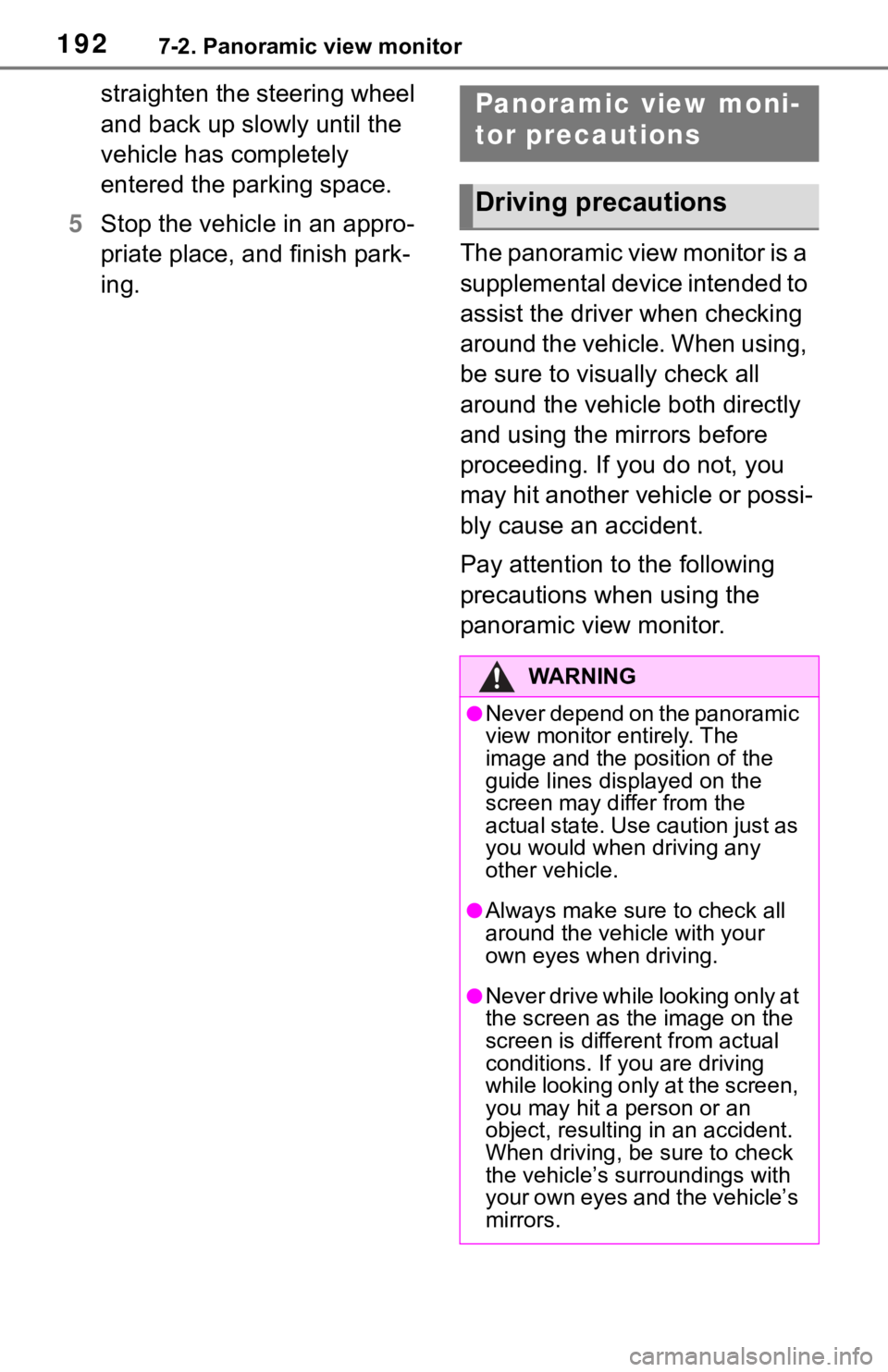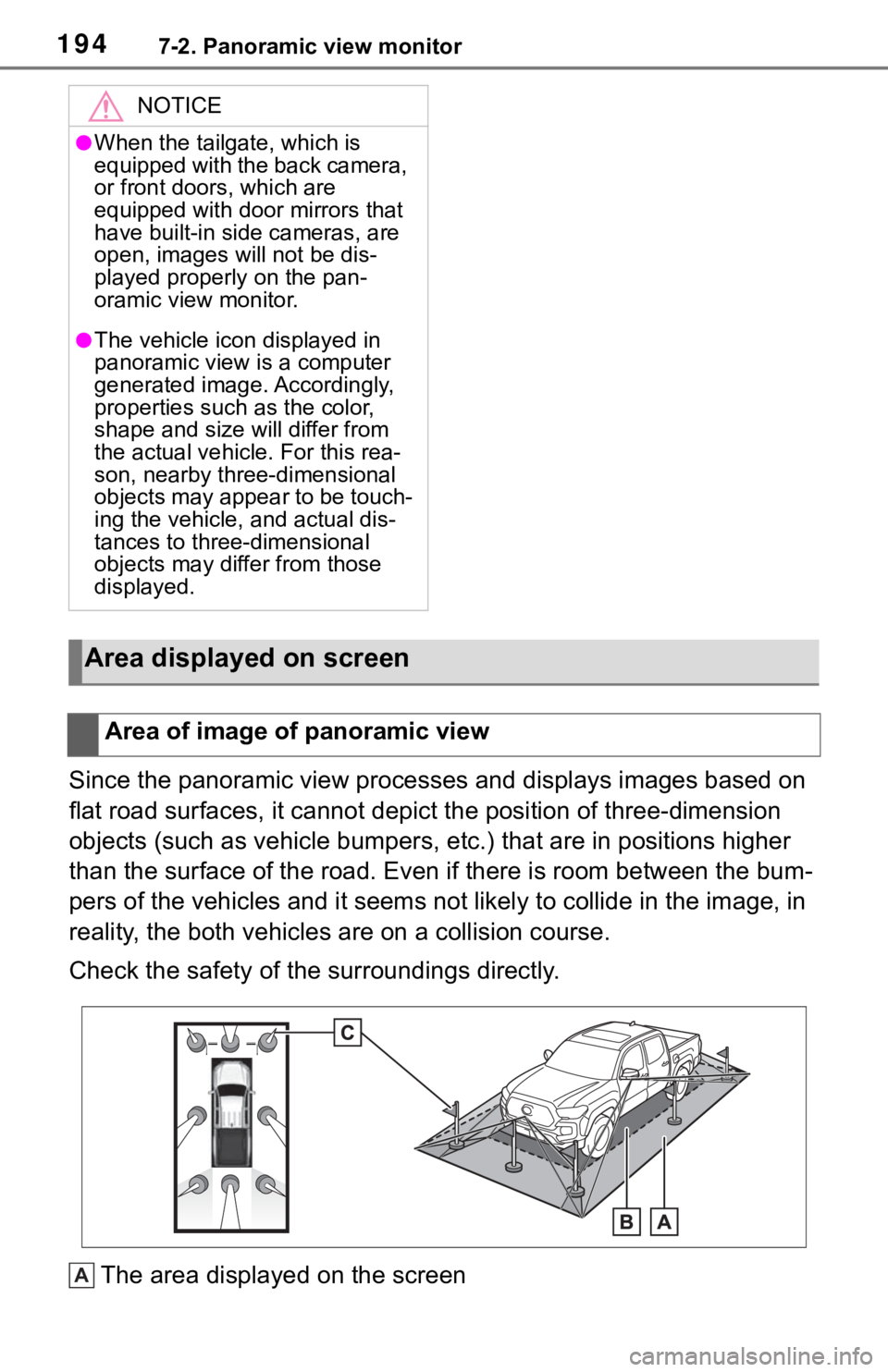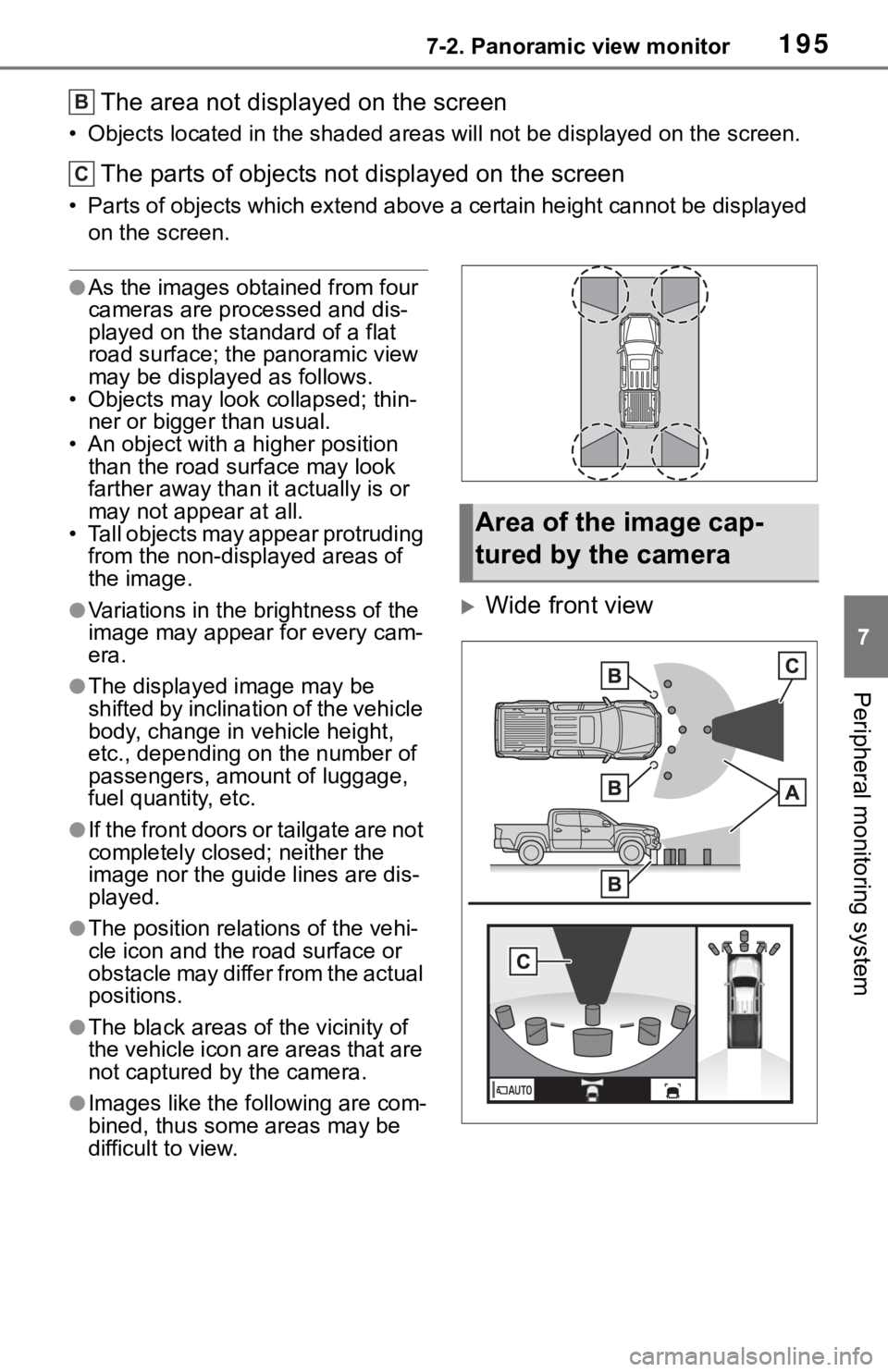Page 190 of 312

1907-2. Panoramic view monitor
Shows the distance behind the vehicle.
• Displays a point approximately 1.5 ft. (0.5 m) (red/blue) from the edge of
the bumper.
Parking assist guide line (blue)
Shows the path of the smallest turn possible behind the vehicle.
When parking in a space which
is in the reverse direction to the
space described in the proce-
dure below, the steering direc-
tions will be reversed.
1Shift the shift lever to the “R”
position.
2Turn the steering wheel so
that the estimated course lines are within the parking
space, and back up slowly.
Parking space
Projected reverse course
lines
WA R N I N G
●Depending on the circumstances of the vehicle (number of passengers,
amount of luggage, etc.), the position of the guide lines displayed on the
screen may change. Be sure to check visually around the vehicle before
proceeding.
●If the steering wheel is straight and the vehicle width guide lines and the
estimated course lines are not in alignment, have the vehicle inspected
by your Toyota dealer.
●Do not use the system if the display is incorrect due to an uneven (hilly)
road or a non-straight (curvy) road.
G
Parking
Using the projected
reverse course line
A
B
Page 192 of 312

1927-2. Panoramic view monitor
straighten the steering wheel
and back up slowly until the
vehicle has completely
entered the parking space.
5Stop the vehicle in an appro-
priate place, and finish park-
ing.The panoramic view monitor is a
supplemental device intended to
assist the driver when checking
around the vehicle. When using,
be sure to visually check all
around the vehicle both directly
and using the mirrors before
proceeding. If you do not, you
may hit another vehicle or possi-
bly cause an accident.
Pay attention to the following
precautions when using the
panoramic view monitor.Panoramic view moni-
tor precautions
Driving precautions
WA R N I N G
●Never depend on the panoramic
view monitor entirely. The
image and the position of the
guide lines displayed on the
screen may differ from the
actual state. Use caution just as
you would when driving any
other vehicle.
●Always make sure to check all
around the vehicle with your
own eyes when driving.
●Never drive while looking only at
the screen as the image on the
screen is different from actual
conditions. If you are driving
while looking only at the screen,
you may hit a person or an
object, resulting in an accident.
When driving, be sure to check
the vehicle’s surroundings with
your own eyes and the vehicle’s
mirrors.
Page 193 of 312

1937-2. Panoramic view monitor
7
Peripheral monitoring system
WA R N I N G
●Depending on the circum-
stances of the vehicle (number
of passengers, amount of lug-
gage, etc.), the position of the
guide lines displayed on the
screen may change. Be sure to
check visually around the vehi-
cle before proceeding.
●Do not use the panoramic view
monitor system in the following
cases:
• On icy or slick road surfaces, or
in snow
• When using tire chains or emer-
gency tires
• When the front door or tailgate
is not closed completely
• On roads that are not flat or
straight, such as curves or
slopes
• If the suspension has been
modified or tires of a size other
than specified are installed
●In low temperatures, the screen
may darken or the image may
become faint. The image could
distort when the vehicle is mov-
ing, or you may become unable
to see the image on the screen.
Be sure to visually check all
around the vehicle both directly
and using the mirrors before
proceeding.
●If the tire sizes are changed, the
position of the guide lines dis-
played on the screen may
change.
●The camera uses a special lens.
The distances between objects
and pedestrians that appear in
the image displayed on the
screen will differ from the actual
distances. (P.198)
NOTICE
●In panoramic view, the system
combines images taken from
the front, back, left and right
side cameras into a single
image. There are limits to the
range and content that can be
displayed. Familiarize yourself
with the characteristics of the
panoramic view monitor system
before using it.
●Image clarity may decline at the
four corners of the panoramic
view. However, this is not a mal-
function, as these are the
regions along the border of
each camera image where the
images are combined.
●Depending on lighting condi-
tions near each of the cameras,
bright and dark patches may
appear on the panoramic view.
●The panoramic view display
does not extend higher than the
installation position and image
capture range of each camera.
●There are blind spots around
the vehicle. Accordingly, there
are regions not displayed in
panoramic view.
●Three-dimensional objects dis-
played in side view, wide front
view or rear view may not be
displayed in panoramic view.
●People and other three-dimen-
sional obstacles may appear
differently when displayed on
the panoramic view monitor.
(These differences include,
among others, cases in which
displayed objects appear to
have fallen over, disappear near
image processing areas, appear
from image processing areas,
or when the actual distance to
an object differs from the dis-
played position.)
Page 194 of 312

1947-2. Panoramic view monitor
Since the panoramic view processes and displays images based on
flat road surfaces, it cannot depict the position of three-dimension
objects (such as vehicle bumpers, etc.) that are in positions higher
than the surface of the road. Even if there is room between the bum-
pers of the vehicles and it seems not likely to collide in the image, in
reality, the both vehicles are on a collision course.
Check the safety of the surroundings directly.
The area displayed on the screen
NOTICE
●When the tailgate, which is
equipped with the back camera,
or front doors, which are
equipped with door mirrors that
have built-in side cameras, are
open, images will not be dis-
played properly on the pan-
oramic view monitor.
●The vehicle icon displayed in
panoramic view is a computer
generated image. Accordingly,
properties such as the color,
shape and size will differ from
the actual vehicle. For this rea-
son, nearby three-dimensional
objects may appear to be touch-
ing the vehicle, and actual dis-
tances to three-dimensional
objects may differ from those
displayed.
Area displayed on screen
Area of image of panoramic view
A
Page 195 of 312

1957-2. Panoramic view monitor
7
Peripheral monitoring system
The area not displayed on the screen
• Objects located in the shaded areas will not be displayed on the screen.
The parts of objects not displayed on the screen
• Parts of objects which extend above a certain height cannot be displayed
on the screen.
●As the images obtained from four
cameras are processed and dis-
played on the standard of a flat
road surface; the panoramic view
may be displayed as follows.
• Objects may look collapsed; thin-
ner or bigger than usual.
• An object with a higher position
than the road surface may look
farther away than it actually is or
may not appear at all.
• Tall objects may appear protruding
from the non-displayed areas of
the image.
●Variations in the brightness of the
image may appear for every cam-
era.
●The displayed image may be
shifted by inclination of the vehicle
body, change in vehicle height,
etc., depending on the number of
passengers, amount of luggage,
fuel quantity, etc.
●If the front doors or tailgate are not
completely closed; neither the
image nor the guide lines are dis-
played.
●The position relations of the vehi-
cle icon and the road surface or
obstacle may differ from the actual
positions.
●The black areas of the vicinity of
the vehicle icon are areas that are
not captured by the camera.
●Images like the following are com-
bined, thus some areas may be
difficult to view.
Wide front view
B
C
Area of the image cap-
tured by the camera
Page 196 of 312
1967-2. Panoramic view monitor
Side views
Rear view
Wide rear view
The area displayed on the
screen
The objects not displayed on
the screen
Black masking
●Black masking is done for dis-
tance detection differences to the
front of the vehicle.
●The area covered by the camera
is limited. Objects which are close
to either corner of the bumper or
under the bumper cannot be seen
on the screen.
●The area displayed on the screen
may vary depending on vehicle
orientation or road conditions.
●The camera uses a special lens.
The distance in the image dis-
played on the screen will differ
from the actual distance.
A
B
C
Page 199 of 312

1997-2. Panoramic view monitor
7
Peripheral monitoring system
■When any part of the vehi-
cle sags
When any part of the vehicle
sags due to the number of pas-
sengers or the distribution of the
load, there is a margin of error
between the guide lines on the
screen and the actual dis-
tance/course on the road.
A margin of errorWhen there are three-dimen-
sional objects (such as vehicle
bumpers, etc.) nearby in posi-
tions higher than the surface of
the road, take extra care when
using the following.
Since the panoramic view pro-
cess and display images based
on flat road surfaces, it cannot
depict the position of three-
dimension objects (such as
vehicle bumpers, etc.) that are
in positions higher than the sur-
face of the road. For example,
even though it appears that
there is space between the
bumpers of the two vehicles in
the illustration below and they
are not likely to collide, in reality,
a collision is about to occur.
A
When approaching three-
dimensional objects
WA R N I N G
●When a sensor indicator on the
intuitive parking assist display
illuminates in red or a buzzer
sounds continuously, be sure to
check the area around the vehi-
cle immediately and do not pro-
ceed any further until safety has
been ensured, otherwise an
unexpected accident may occur.
Panoramic view display
Page 200 of 312
2007-2. Panoramic view monitor
Since the projected course
lines is displayed for a flat
road surface, it can not depict
the position of three-dimen-
sional objects (such as vehi-
cle bumpers, etc.) that are in
positions higher than the sur-
face of the road. Even if the
bumpers of the vehicle is on
the outside of the projected
course lines in the image, in
reality, the vehicles are on a
collision course.Projected course lines
Three-dimensional objects
(such as the overhang of a
wall or loading platform of a
truck) in high positions may
not be projected on the
screen. Check the safety of
the surroundings directly. Projected course lines
A